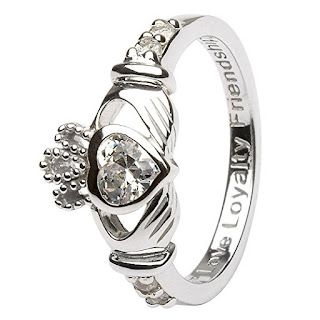In earlier posts I’ve talked about how the wedding
engagement ring tradition can be traced back to ancient Romans and even further back to the book of Genesis when rings where given as pledges. Today, we are only going
to look back as far as the Middle Ages, when the Scots started their own
wedding engagement tradition of giving a fede ring. But unlike today’s
practices, these silver Scottish engagement rings weren’t given to the bride-to-be,
but instead was handed over to church (kirk) when making arrangements for proclaiming
the marriage. Along with the fede ring, the Scots practiced two other
engagement traditions: the giving of the Luckenbooth Brooch and Claddagh Ring.
Fede ring
The design of the silver fede ring included two hands which
met in a clasp representing friendship, love or betrothal. This design is also
historically thought to date back to ancient Rome or before.
Luckenbooth brooch
The Lukenbooth brooch tradition dates back to the
early 1700s when silver and gold smiths sold merchandise in an open market
along the Royal Mile, next to to Edinburgh Castle. At this time, open-market
stalls were swapped for booths that could be locked after closing, and this is where
the name luckenbooth (locked booth) comes from.
The jewelers crafted these brooches with designs
including intertwining hearts beneath a crown which symbolized Mary Queen of
Scots. Even the hearts often were shaped to create an “M” after the fashion of
the Queen’s monogram.
Another wedding tradition included having these
brooches engraved with a pledge of love. After the wedding, the bride often
tucked the brooch away as a special keepsake. When the union was blessed with a first child, the brooch was pinned to the christening gown or blanket. Then it was
tucked away until that firstborn’s own betrothal.
For those in America, an interesting twist on this
tradition took place in the 18th century when the Iroquois Indians
of North America traded for Luckenbooth brooches!
Today the giving of a Luckenbooth brooch as a token of
betrothal is still considered one of the most romantic symbols of love.
Claddagh ring
The Claddagh ring was also worn as an engagement
ring. In fact, depending on how you wear the Claddagh ring it has different meanings including
friendship, betrothal, or marriage. This ring design includes hands meeting
(friendship) clasping a heart (love), topped with a crown which represents
loyalty. Today this is probably the most popular traditional betrothal gifts exchanged
as a token of unfailing love.
* * *
Some links in this post are affiliate links. We are a
participant in the Amazon Services LLC Associates Program, an affiliate
advertising program designed to provide a means for us to earn fees by linking
to amazon.com and affiliate sites.
Thanks so much for being part of our success.











